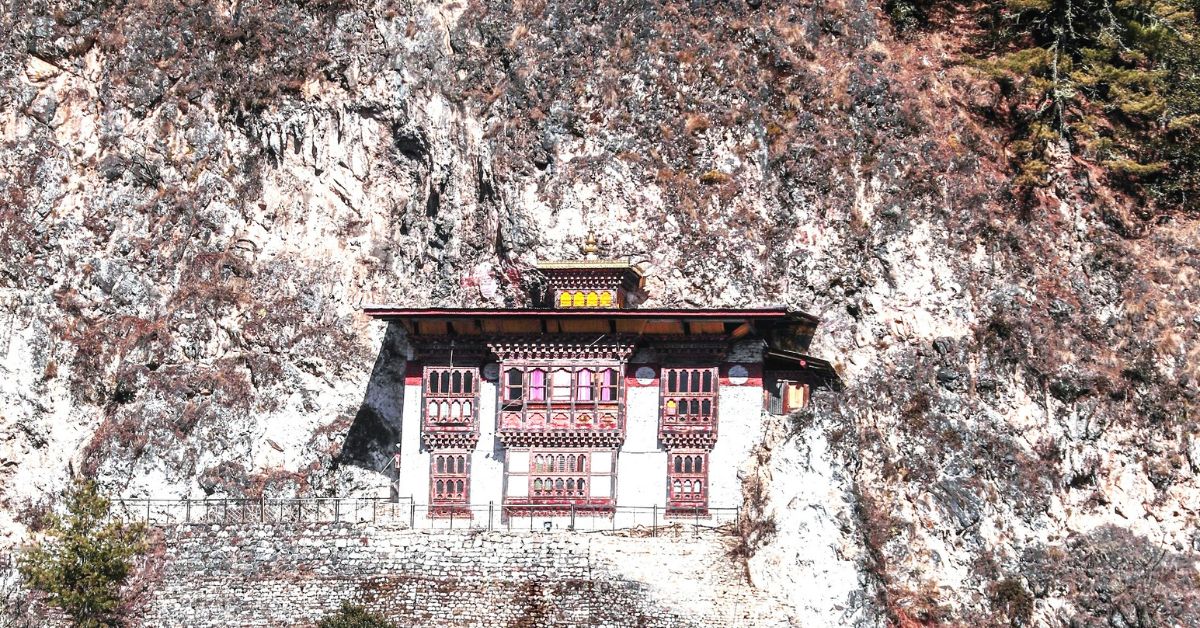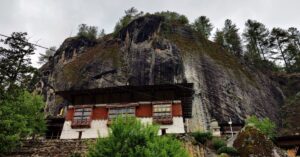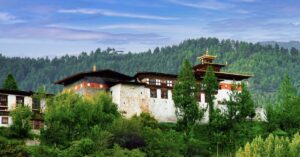Shelkar Drak Lhakhang, also known as Shekhar Dra Goemba, is a small temple located on the south face of Avalokiteshvara Hill in Haa Dzongkhag. The temple was founded by Choglay Jigme Tenzin, the sixth Sungtrul (speech incarnation) of Zhabdrung Rinpoche.
Shelkar Drak means “white crystal cliff” or, more loosely, “crystal crag,” referring to the limestone cliff, which pilgrims had partly whitewashed. The Lhakhang is built similarly to the famous Taktsang Monastery of Paro and seems to naturally rise from the cliffside, with some features partially hidden and others visible.
How to Reach Shelkar Drak Lhakhang
Shelkar Drak monastery is perched high up on the white crystal cliff. Take the unpaved side road past the Lhakhang Nagpo, and continue up the hillside via the recently renovated Takchu Goenzin Dratshang on the ridgetop.
From Lungsukha village, marked by a small private Lhakhang and a white chorten, a 15-minute walk along a newly constructed road leads to the Lhakhang.
For a unique return, descend from the Lhakhang past the Chimey Dingkha pool, adorned with prayer flags, to reconnect with the main road.
History of Shelkar Drak Lhakhang
Shelkar Drak Lhakhang was founded by Choglay Jigme Tenzin, the sixth Sungtrul (speech incarnation) of Zhabdrung Rinpoche.
According to history, Guru Rinpoche visited the site in the 8th century. The exact date of Shelkar Drak Lhakhang’s founding remains unknown. It is believed that the temple was established as early as the mid-19th century, if not earlier. The fourth Sungtrul Jigme Norbu is said to have written a prayer book dedicated to Dorji Zebar, the local deity of Shelkar Drak Lhakhang.
However, the founding of Shelkar Drak Lhakhang is attributed to Choglay Jigme Tenzin, the sixth Sungtrul (speech incarnation) of Zhabdrung Rinpoche. He is said to have studied Buddhist philosophy, Tantric rituals, and various sutras during his time here.
Legends and Miracles
Shelkar Drak Lhakhang is linked with several miraculous events. Locals recount having seen a nearby juniper tree emit smoke like a sacred flame, though the tree itself did not burn. At Khamthangkha, the stupa is said to have trembled gently when sincere prayers are offered, releasing blessed holy water (Thruechu).
Therefore, such wonders make the Shelkar Dra temple a sacred place of pilgrimage in Haa Valley.
Description of Shelkar Drak Temple
Shelkar Drak Lhakhang is a small cliffside retreat center perched on a limestone cliff (Shelkar Drak). The temple is intricately carved into the rock face, as if it had grown naturally from the cliff, blending seamlessly with the surrounding rocks and trees.
The main Lhakhang houses a statue of Dorje Dzinpa (or Dorji Zebar), a local protective deity, and the founder, Choglay Jigme Tenzin. Today, the temple is attended by one lama and an attendant monk who serve pilgrims from around the world.
Around the sacred cliff and temple, there are many small, hidden hermitages where nuns have meditated for years. A short 10-minute climb leads to the meditation cave of Machig Labdron, the 11th-century Tibetan yogini and founder of the Chod tradition.
Best Time to Visit Shelkar Drak Lhakhang
The best time to visit the Haa Valley is typically from March to May and from September to November, when it is ideal for a pilgrimage to the sacred cliff blessed by Guru Rinpoche. You can visit the major pilgrimage sites of Haa with the Bhutan Pilgrimage Package.
Places to Explore in Haa
Rangtse Ney: A sacred abode of Guru Rinpoche located in Chego village under Haa Dzongkhag at an altitude of 879 meters above sea level.
Lhakhang Nagpo: Also known as the “Black Temple”, it is a one-story temple founded by Songtsen Gampo in 659 CE in the Haa Valley.
Lhakhang Karpo: Also known as the “White Temple”, it is a one-story temple founded by Songtsen Gampo in 659 CE to subdue a demoness in the Haa Valley.
Jo Bay Tsho: A hidden lake that stretches approximately 300 by 200 meters in length, nestled along the border of Sombaykha and Gakiling Gewogs in Haa.
Enjoyed reading this blog?




